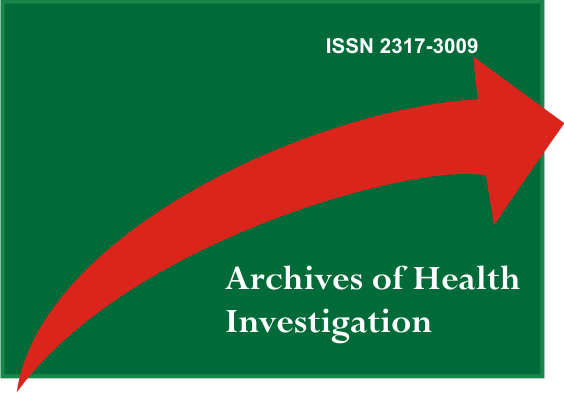Superior orbital fissure syndrome after facial trauma
DOI:
https://doi.org/10.21270/archi.v6i6.2080Resumo
The superior orbital fissure is a crack that communicates with the middle cranial fossa and is located between the greater and lesser wings of the sphenoid in the posterior region of the orbit. It presents a close relationship with several important structures such as the optic foramen and II, III, IV, V and VI cranial nerve and the sphenoid and ethmoid sinuses. Zygomatic-orbital fracture may trauma in the posterior region of the orbit and may result in the Superior Orbital Fissure Syndrome (SOFS) or Apex Orbital Syndrome (AOS). The superior orbital fissure syndrome results from compression structures that pass this region, resulting in paralysis of the cranial nerves III, IV and VI. Clinically, the patient has ptosis, mydriasis and ophthalmoplegia, it is very important that the diagnosis is made before the surgical manipulation of reduction and fixation of zygomatic fracture. Case report: A male patient, 37, hit and run victim was survived by Trauma Surgery Team. Diagnosed with head trauma and diffuse axonal injury, it was transferred to the Intensive Care Unit (ICU) where he stayed for three weeks. It was conducted by the Oral and Maxillofacial Surgery and was diagnosed zygomaticomaxillary fracture type Le Fort III and mandibular fracture associated with SOFS. The surgical treatment of mandibular and zygomaticomaxillary fractures was conducted. The ptosis devolved and postoperative 6 months was noted complete remission of the syndrome signals.Descriptors: Craving; Optical Nerve; Syndrome; Cranial Nerve.
Downloads
Referências
Yeh S, Foroozan R. Orbital apex syndrome. Curr Opin Ophthalmol. 2004; 15(6):490-8.
Foroozan R, Bhatti MT, Rhoton AL. Transsphenoidal diplopia. Surv Ophthalmol. 2004; 49(3):349-58.
Kline LB. The Tolosa–Hunt syndrome. Surv Ophthalmol. 1982;27(2):79-95
McAvoy CE, Lacey B, Page AB. Traumatic superior orbital fissure syndrome. Eye (Lond). 2004; 18(8):844-5.
Ykeda RB, Ballin CR, Moraes RS, Ykeda RB, Miksza AF. Epidemiological profile of 277 patients with facial fractures treated at the emergency room at the Ent Department of Hospital do Trabalhador in Curitiba/PR, in 2010. Int Arch Otorhinolaryngol. 2012; 16(4):437-44.
Gabikian P, Chowdhary AM, Kott B, Lazar DA, Britz GW. Isolated Superior Orbital Fissure Syndrome Resulting From Gunshot Wound to the Head. Curr Probl Diagn Radiol. 2012; 41(4):112-3.
Bun RJ, Vissink A, Bos RR. Traumatic superior orbital fissure syndrome: Report of two cases. J Oral Maxillofac Surg. 1996;54(6):758-61.
Taylor KH, Mizen KD, Spencer N. Isolated fracture of the superior orbital fissure Br J Oral Maxillofac Surg. 2010; 48(3):178-9.
Rowe NL, Williams JL (eds). Maxillofacial injuries. Edinburgh: Churchill Livingstone; 1985.
Paza AO, Farah GJ, Passeri LA. Traumatic carotid cavernous fistula associated with a mandibular fracture. Int J Oral Maxillofac Surg. 2008;37(1):86-9.


